PNY GTX 1650 XLR8 Gaming Overclocked Edition Review
PNY GTX 1650 XLR8 Gaming Overclocked Edition Review
A budget Full HD graphics card
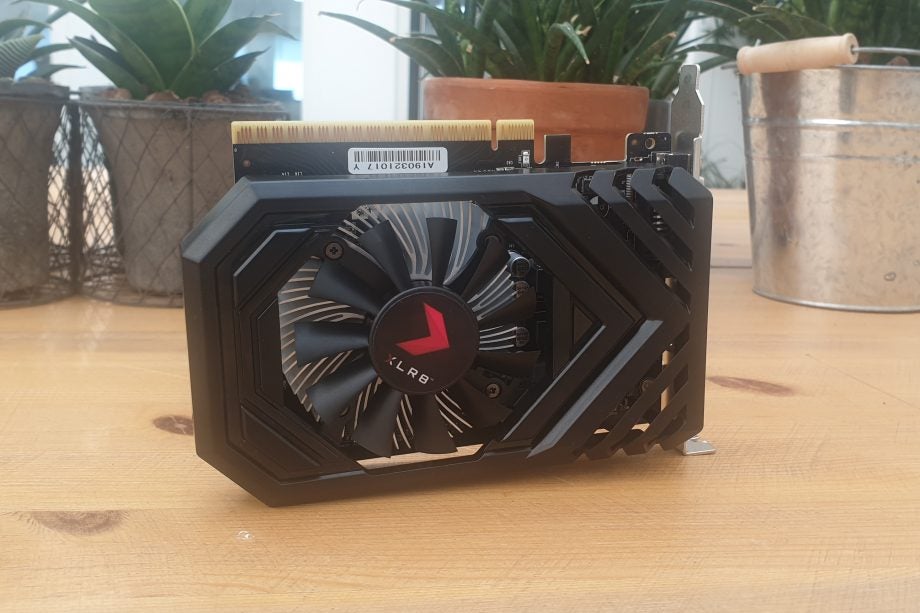
Verdict
The PNY GTX 1650 is an extremely cheap graphics card capable of a smooth Full HD performance with the likes of Apex Legends and Fortnite. But the fact it can't run any modern blockbuster titles at 60fps without scaling down the graphics quality is massive turn off, especially since there are far better value alternative graphics cards that only cost a little bit more.
Pros
- Solid Full HD performance for battle royale games
- Super cheap
- Ideal size for compact cases
Cons
- Struggles to run modern AAA games in Full HD at 60fps
- GTX 1660 and GTX 1660 Ti offer far better value
- Limited display ports
Key Specifications
- Review Price: £150
- Turing architecture
- 896 CUDA Cores
- 1485MHz base clock speed
- 1725MHz boosted clock speed
- 4GB GDDR5 VRAM
What is the PNY GTX 1650 XLR8 Gaming Overclocked Edition?
The PNY GTX 1650 XLR8 Gaming Overclocked Edition is a new graphics card based on Nvidia’s cheapest 16 Series GPU. With no Founders Edition model of the GPU, we’ve instead tested the third-party PNY variant.
The 16 Series graphics cards are aimed at those not willing to shell a significant amount of cash on fancy features such as ray tracing and DLSS (Deep Learning Super Sampling), but still want to see a decent performance for Full HD gaming. The GTX 1660 Ti is our current champion for that criteria, but the GTX 1650 here sees the price hammered down even further, consequently seeing a diluted performance.
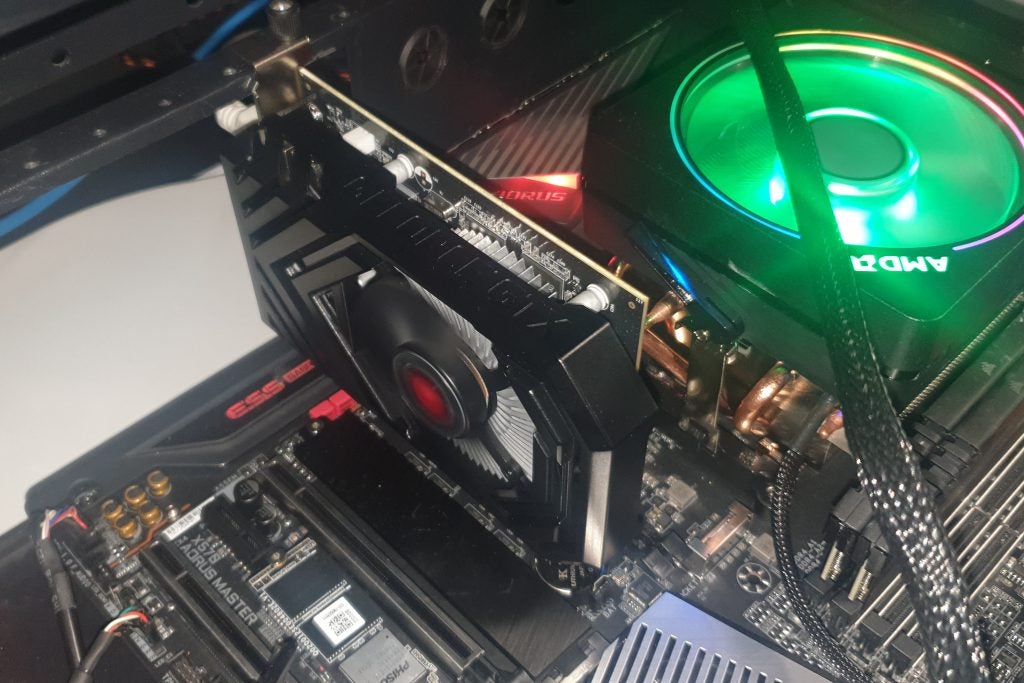
The PNY GTX 1650 graphics card is absolutely tiny and will fit in almost any PC case
The GTX 1650 is effectively a replacement for Nvidia’s GTX 1050 graphics card, delivering boosted specs and performance without seeing a major price increase. The most notable difference between the GTX 1650 and its GTX 1050 predecessor though, is the jump to the new Turing architecture known as TU116.
This Turing architecture gives the GTX 1650 new Turing shader innovations, using the card’s GPU grunt more efficiently to drive up frame rates. But despite how impressive and effective these smart shading techniques are, they can’t quite make up for the underwhelming specs.
Related: Best Graphics Cards 2019
Specs and technology
- The PNY GTX 1650 has Turing architecture, but lacks ray tracing
The table below shows the specs of the GTX 1650 and how it compares to other Nvidia-based graphics cards including the GTX 1050, GTX 1060, GTX 1660 and GTX 1660 Ti.
| GTX 1650 (PNY) | GTX 1050 2GB (EVGA) | GTX 1060 6GB (Nvidia) | GTX 1660 (Gigabyte) | GTX 1660 Ti (PNY) | |
| Architecture | Turing | Pascal | Pascal | Turing | Turing |
| CUDA Cores | 896 | 640 | 1280 | 1408 | 1536 |
| Base clock speed | 1485 | 1354 | 1506 | 1530 | 1500 |
| Boost clock speed | 1725 | 1455 | 1708 | 1785 | 1770 |
| VRAM | 4GB GDDR5 | 2GB GDDR5 | 6GB GDDR5 | 6GB GDDR5 | 6GB GDDR6 |
| Memory bandwidth | 128 | 112 | 192 | 192 | 288 |
| TDP | 75W | 75W | 120W | 120W | 120W |
| Price | £150 | £130 | £230 | £199 | £260 |
In terms of specs alone, the PNY GTX 1650 essentially looks like a boosted GTX 1050 graphics card. It’s seen an increase in CUDA Cores, clock speeds, video RAM and memory bandwidth, but rarely by a significant margin. The GTX 1650 can’t quite match the specs of the slightly more powerful GTX 1060 6GB though.
The GTX 1650 does have one major advantage over both the GTX 1050 and GTX 1060 though, as it’s jumped to the new Turing architecture.
Unlike Nvidia’s more expensive RTX graphics cards, the Turing architecture doesn’t gift the GTX 1650 ray tracing powers. Instead, Nvidia claims the budget-friendly GPU’s new Turing shaders see 1.4x improved power efficiency over the previous Pascal architecture, which not only boosts performance but supposedly also sees a “cooler and quieter gaming experience”.
Related: What is ray tracing?
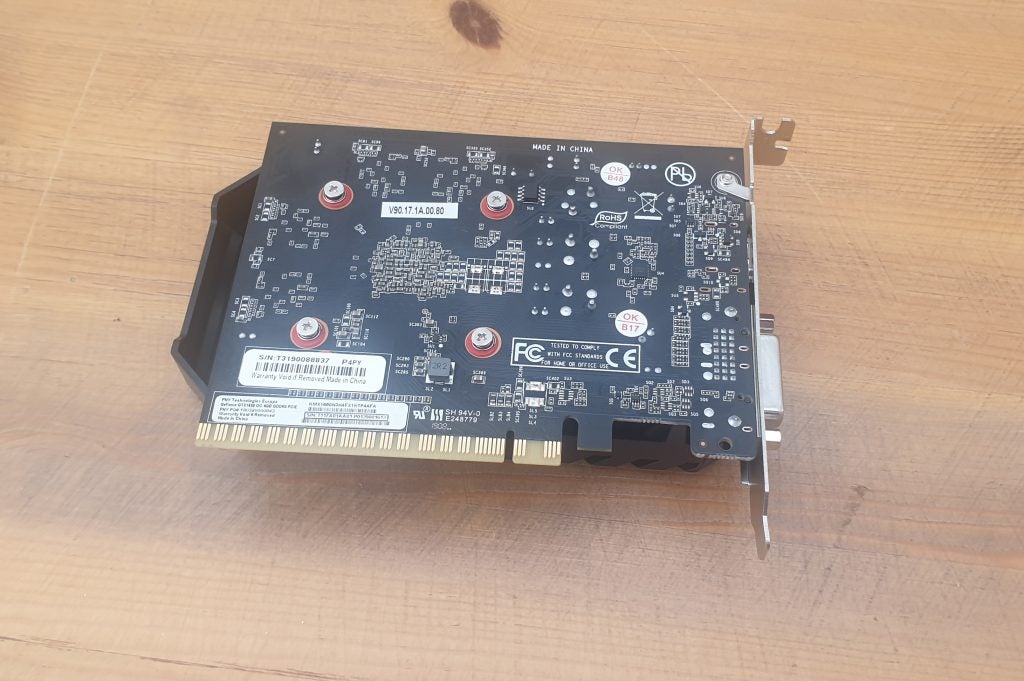
The GTX 1650 is essentially a specced up version of the GTX 1050 graphics card
The biggest magic trick this GPU is capable though is Variable Rate Shading (VRS). This super smart rendering technique looks for ways to reduce the GPU workload without impacting the visual quality. For example, the GPU will acknowledge there’s no need to render a road in high detail if your blitzing past it at high speed in a racing car. The GPU also doesn’t need to work too hard to continuously shade motionless objects and scenery such as the sky or a wall.
The catch with this Adaptive Shading however, is it only works efficiently with modern games that take advantage of this advanced technology. Games such as Shadow of the Tomb Raider and Call of Duty Black Ops 4 will see a significant boost, but older titles such as Fallout 4 will see less of a benefit.
Design and connectors
- The PNY GTX 1650 is a small and simple graphics card
The PNY GTX 1650 is a cute little graphics card, rocking a single fan and plastic frame. It’s not extravagant, lacking the RGB lights and premium trimmings found with more pricey cards, but that’s hardly a surprise given the budget price.
At only 1.45mm long, this graphics card will easily fit in your rig, even if you’ve got a compact mini ATX case. Weighing in at approximately 99.8g, this graphics card is incredibly light too.
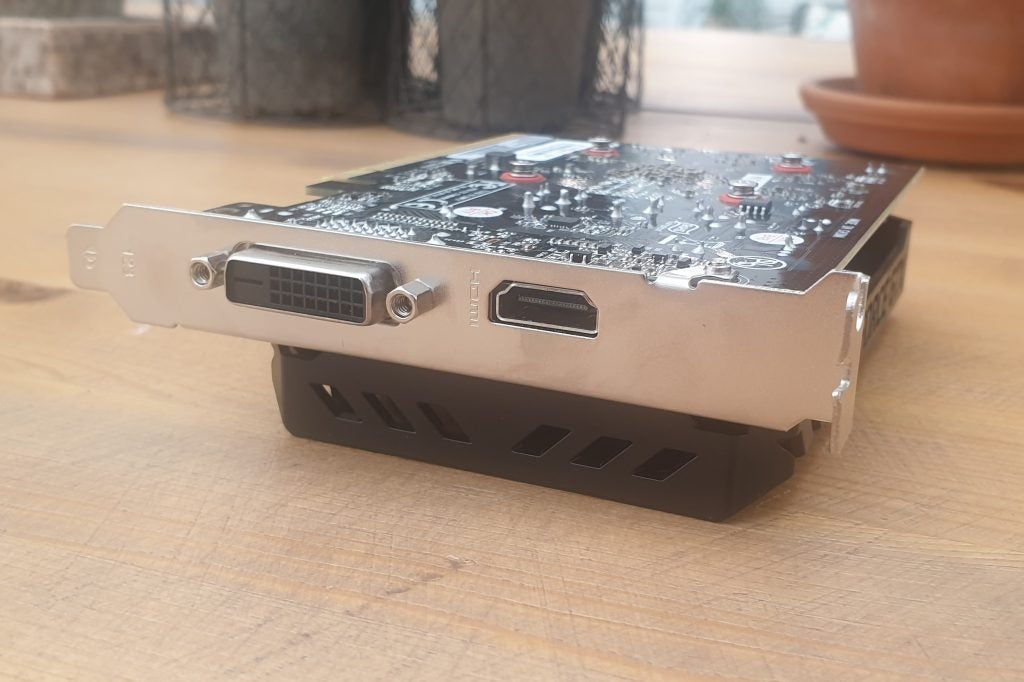
The lack of DisplayPort means you might struggle to hook the PNY GTX 1650 to select monitors
The biggest downside of the PNY GTX 1650 design is the absence of a DisplayPort connection, which was awkward during testing as our 4K monitor doesn’t support HDMI. Then again, anyone with an Ultra HD monitor likely won’t be looking to buy a graphics card limited to Full HD performance. Instead, the PNY GTX 1650 has ports for both HDMI 2.0 and DVI-D, which should satisfy the majority of HD gamers.
Related: AMD RX 5700
Performance and benchmarks
- The PNY GTX 1650 is an improvement on the 1050, but it’s no powerhouse
The PNY GTX 1650 is a graphics card designed specifically for Full HD gaming. For this reason, I only tested the GTX 1650 at a 1920 x 1080 resolution, but did fiddle with the graphics presets to see how far we could boost the frame rates by sacrificing visual quality.
Testing methodology
In order to ensure a fair test for all the graphics cards, I benchmarked every GPU on the same computer rig. This means the motherboard, processor, PSU, SSD and operating system were all kept consistent. You can see the full list of components used below.
Motherboard: X570 Aorus Master Gaming
Processor: AMD Ryzen 9 3900X
RAM: Corsair Vengeance 2666MHz, 16GB DDR4
PSU: Corsair CX750M
OS: Windows 10
The games we used for the benchmark tests were also carefully selected. Shadow of the Tomb Raider and The Division 2 are two highly GPU-intensive titles, but should also make use of the GTX 1650’s Turing shader innovations. Apex Legends, meanwhile, isn’t too demanding on the GPU, but does take advantage of the Adaptive Shading for a performance boost.
Dirt Rally won’t see the benefit of this Turing technology though, but is a good representative for games released a number of years ago, which should be useful for those looking to play through a backlog.
I benchmarked each game (where possible) with the ‘Ultra’, ‘Medium’ and ‘Low’ presets, but always kept the resolution at 1920 x 1080. While you’ll ideally want to play every game with the visual settings whacked to the max, the GTX 1650 doesn’t always offer a steady performance unless you dial down the settings.
Otherwise, the only other setting adjustment I did was turning off Vsync, which can influence the GPU performance depending on the refresh rate of the monitor. I used the following graphics cards for the benchmark tests:
- PNY GeForce GTX 1650 XLR8 Gaming Overclocked Edition
- EVGA GeForce GTX 1050 Gaming
- Nvidia GeForce GTX 1060
- PNY GeForce GTX 1660 Ti
Shadow of the Tomb Raider
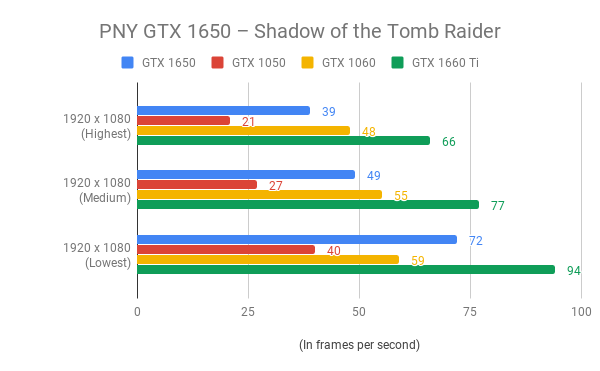
The positive here is the GTX 1650 is clearly an upgrade on the GTX 1050, effectively making the latter redundant with such a minor price difference. But you could also argue the GTX 1050 long became outdated since it’s not powerful enough to comfortably play most modern video games these days.
The greatest concern for the GTX 1650 is that it can’t hit 60fps at the Highest or even Medium graphics presets. You’ll have to turn down the settings to ‘Lowest’ to achieve an ideal performance, but I wouldn’t recommend that since all the textures end up looking terrible.
Meanwhile, the GTX 1660 Ti may cost £100 more but since it offers a 27fps improvement on the GTX 1650 and clears the 60fps optimum target with ease. I’d definitely suggest stumping up the cash for the significantly superior card.
The Division 2
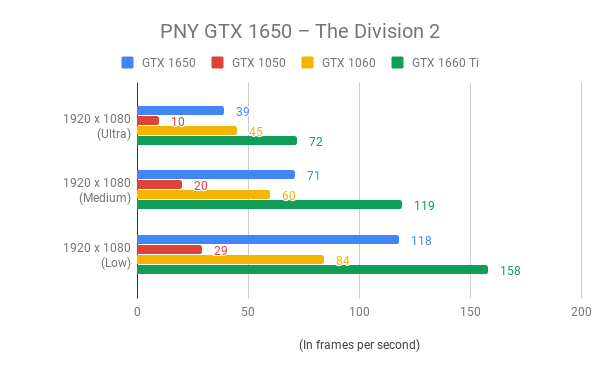
The Division 2 is the most GPU demanding title on this test, which is illustrated via the poor average frame rate scores of the GTX 1050 and GTX 1060. The two Turing cards perform noticeably better though, likely because of the Turing Shader innovations. Nvidia claims such technology will perform better when a video game utilises advanced shading techniques, and we can see that in full effect here.
The GTX 1650 sees a whopping 29fps boost compared to the GTX 1050 when set to the ‘Ultra’ graphics preset. That said, with the average frame rate only at 39fps, the performance is a little more choppy than I’d like with 60fps being the ideal target.
The GTX 1660 Ti also benefits from the Turing shader performance boost, but also boasts a 33fps advantage over the GTX 1650 thanks to its beefy specs. Sure, you’ve got to spend an extra £100 or so to get the superior card, but for future proofing and a stable performance with modern games, I seriously recommend the pricier purchase.
But if your budget is super strict, the GTX 1650 at least sees a respectable 71fps with the graphics setting lowered to ‘Medium’. You’ll see a moderate blow to the visuals, but at least this GPU can still deliver a stable performance.
Dirt Rally
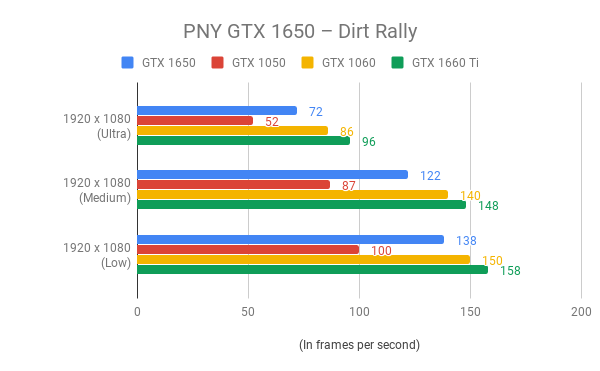
If you fancy a cheap graphics card to exclusively play video games released at least 4 or 5 years ago, then the Dirt Rally benchmark showed encouraging results for the GTX 1650. With all the graphics settings adjusted to ‘Ultra’, the GTX 1650 achieved an average frame rate of 72fps which comfortably clears the 60fps target.
This performance level is 20fps better than what the GTX 1050 is capable, proving there’s little point investing in the previous generation Pascal card now.
Scale down the graphics settings, and you can even surpass 100fps with Dirt Rally, but the visible performance gain would be so minimal there’s little reason sacrificing the visual quality.
This is the only instance where I’d recommend the GTX 1650 over the GTX 1660 Ti, as despite the latter boasting a 24fps frame rate advantage, the noticeable difference probably won’t justify the extra £100. But are you really going to be happy playing nothing but old video games and indie titles?
Apex Legends
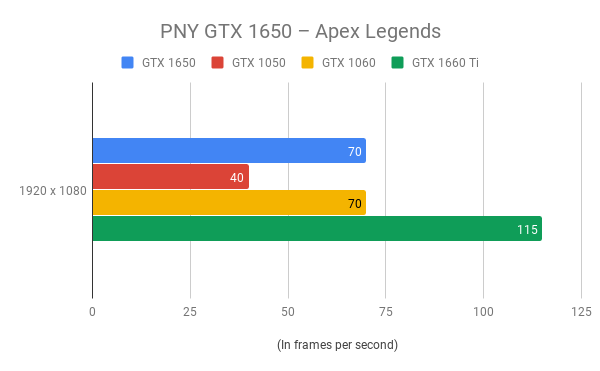
When Nvidia announced the new 16 Series graphics cards, the company made a big song and dance about how effective the new Turing shaders are at boosting performance for battle royale titles, particularly Fortnite and Apex Legends. It was here where the GTX 1650 excelled, providing an excellent 70fps average in Full HD when playing Apex Legends.
This result not only bested the GTX 1050 by a gargantuan 30fps, but also equalled the GTX 1060 card despite the Pascal card offering superior specs and costing approximately £80 more.
The GTX 1660 Ti also shares these sharder talents though, so it still remains a tempting proposition to upgrade to the more powerful graphics card and enjoy a 45fps increase.
If you’re happy to snub modern AAA games (think Witcher 3 and The Division 2) in favour of battle royale titles like Fortnite and Apex Legends, then the GTX 1650 will serve you well and represents great value – but that’s likely a limited audience, especially when you can grab a PS4 or Xbox One for the same price which do the whole shabang for a similar price.
3DMark Fire Strike Ultra
The 3DMark Fire Strike Ultra benchmark is useful for seeing the raw GPU performance power of a graphics card. Such a test doesn’t take clever shading innovations into consideration like what’s found with the 16 Series cards, but is still useful to see how various graphics cards compare.
In summary, this isn’t a particularly powerful card. The 1773 score posted by the GTX 1650 was (as expected) sandwiched between the performance of GTX 1050 and GTX 1060, and lagged behind the 3381 GTX 1660 Ti result by a significant margin.
The positive side of not being a powerful graphics card is that it doesn’t demand a lot of power. The 180.1 watt power consumption we saw from the 3DMark Fire Strike Ultra benchmark test is noticeably lower than the GTX 1060 and GTX 1660 Ti results. This means you should be able to keep costs to a minimum with a cheap PSU.
Despite only having one fan, the PNY GTX 1650 never saw temperatures rise to concerning heights, remaining at a cool 65°C during the benchmark test. This is typical for Nvidia cards, and means you’ll be able to fit the graphics card in a Micro ATX case without fear of your components frying.
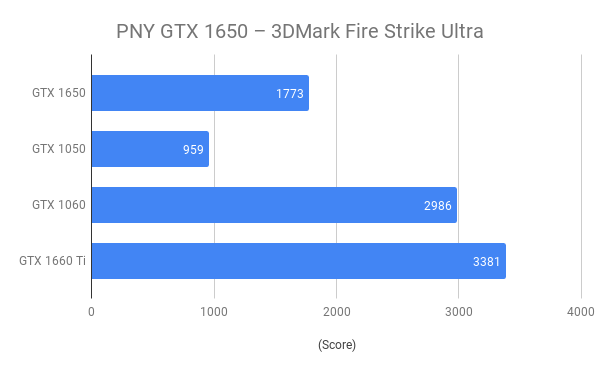
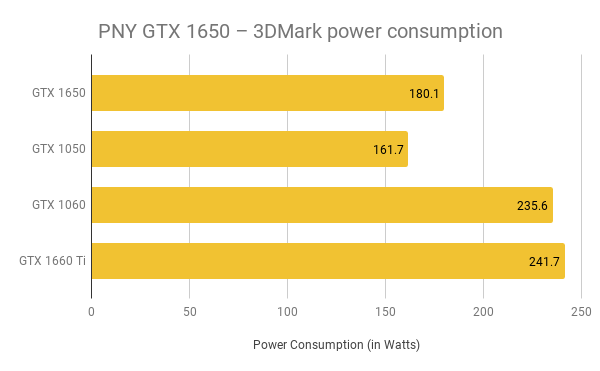
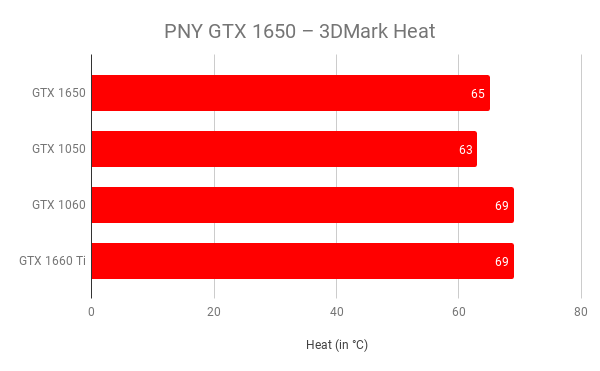
Related: Best PC Games 2019
Overclocking
- The PNY GTX 1650 doesn’t see much of a boost from overclocking
Being a budget Full HD graphics card, I never expected the GTX 1650 to flaunt an excellent overclocking performance and my estimations proved correct following tests via MSI Afterburner.
Running the Unigine benchmark software, I was able to achieve a 175MHz overclock with the GTX 1650. This seems impressive initially, but this only saw the frame rate rise by 4fps. Such a minimal improvement isn’t really worth the extra effort. If I tried to push the GPU any further, the Unigine software would become choppy and unstable.
The temperature never surpassed 67°C during the overclocking tests, proving the thermal performance isn’t bottleneck here. It’s looks like the GPU just isn’t capable of a supeior performance.
Should I buy the PNY GTX 1650?
The PNY GTX 1650 is a budget graphics card option for Full HD gamers – that is said with an asterix though. The GPU fails to hit the ideal 60fps target with modern AAA games such as Shadow of the Tomb Raider and The Division 2, leaving you with the tough decision whether to sacrifice visual quality for a more reliable performance.
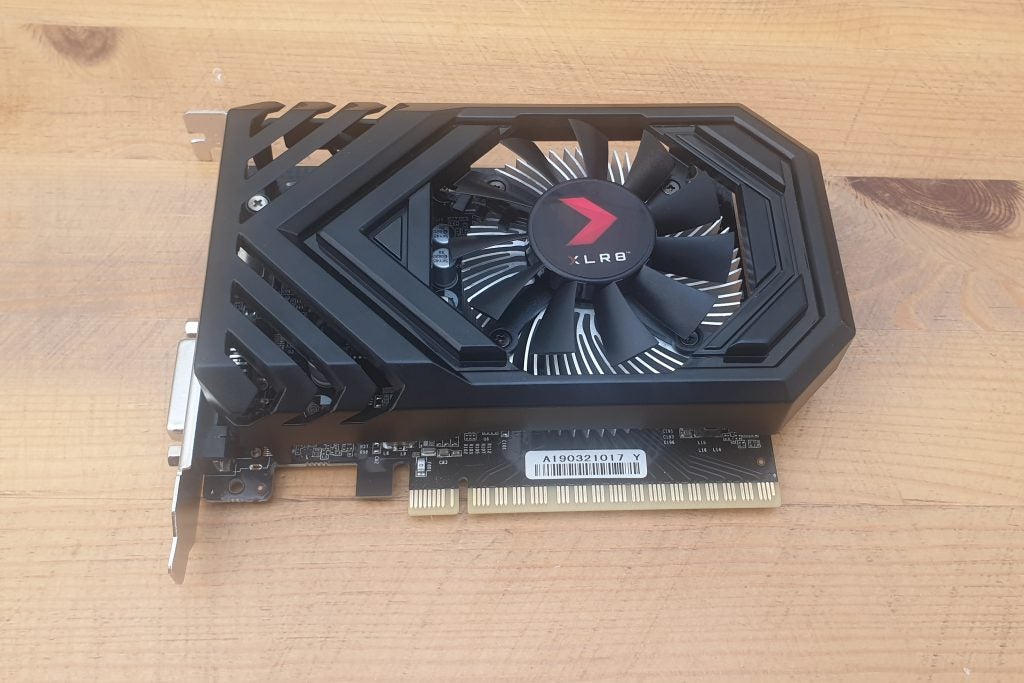
The PNY GTX 1650 is super cheap, but struggles to play blockbuster games in 60fps at Full HD
If you’re hoping to play upcoming blockbuster games such as Cyberpunk 2077 and Watch Dogs Legion, then the PNY GTX 1650 isn’t worthy of your rig. The more expensive GTX 1660 Ti is a far better value purchase, priced at £100 more, and is future-proofed for years.
But if you’re happy to be limited to playing battle royale and indie titles, as well as the majority of AAA games released in 2015 at the very latest, then the GTX 1650 is still a bargain buy for gamers with a strict budget.
Verdict
The PNY GTX 1650 is an extremely cheap graphics card capable of a smooth Full HD performance with the likes of Apex Legends and Fortnite. But the fact it can’t run any modern blockbuster titles at 60fps without scaling down the graphics quality is massive turn off, especially since there are far better value alternative graphics cards that only cost a little bit more.


